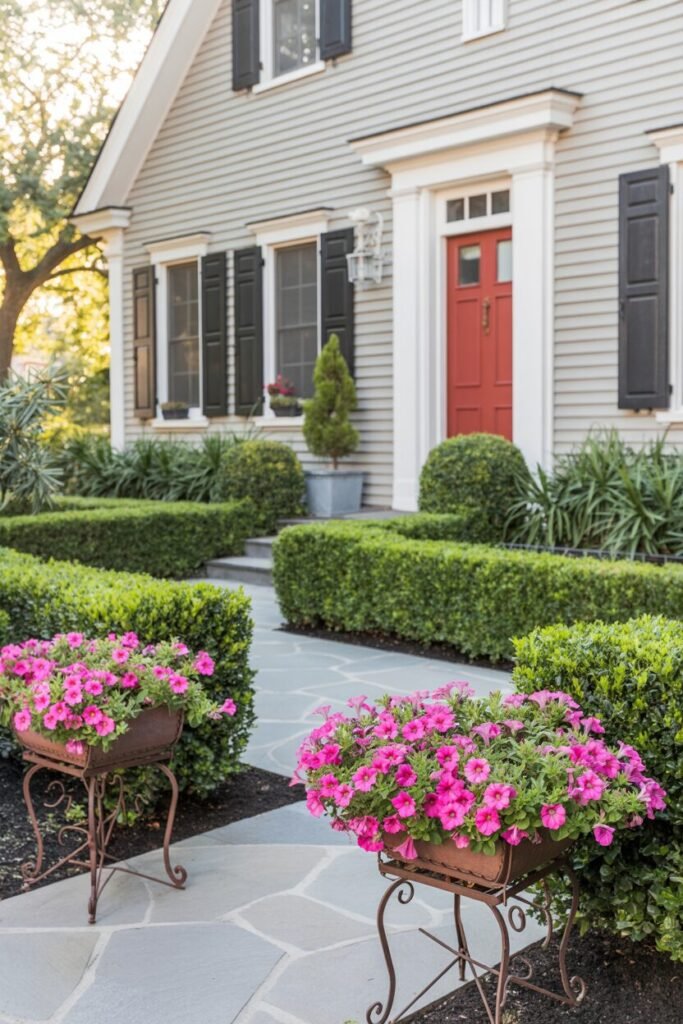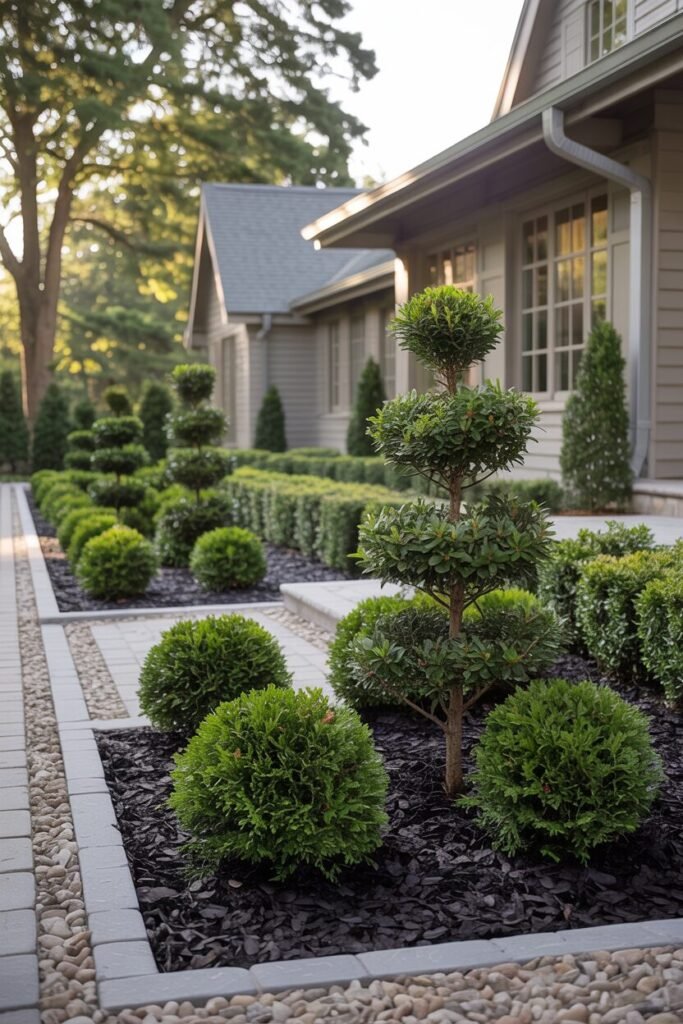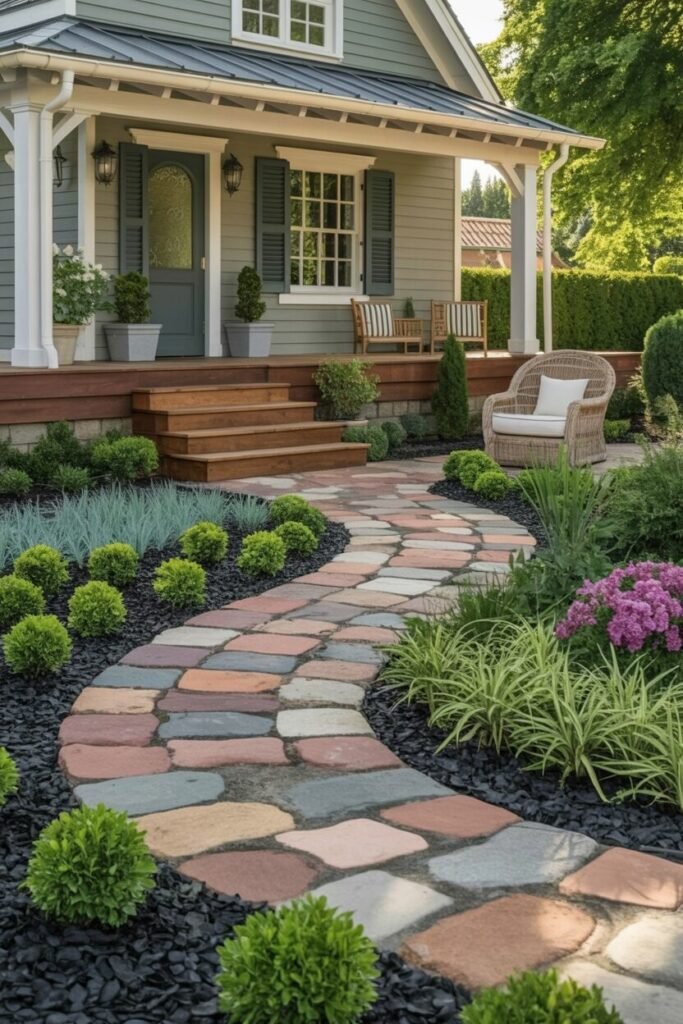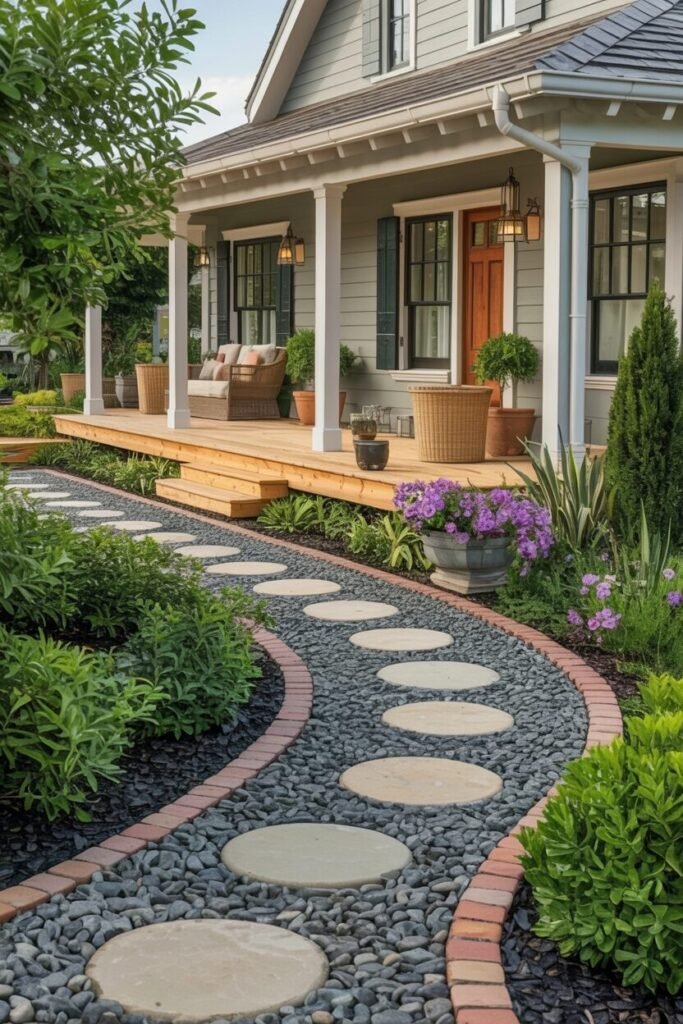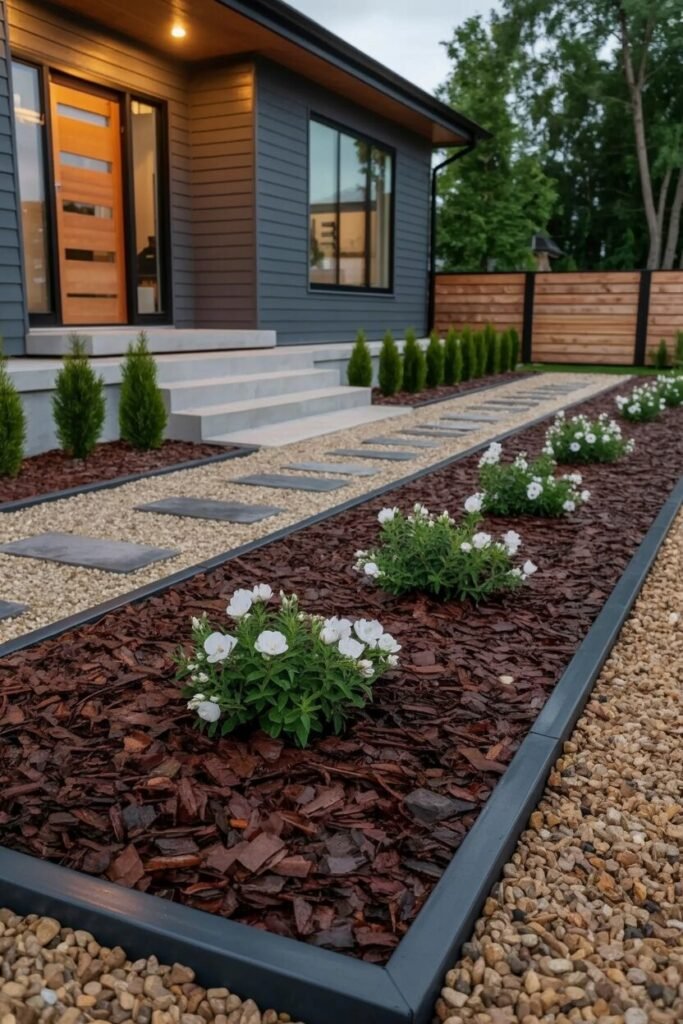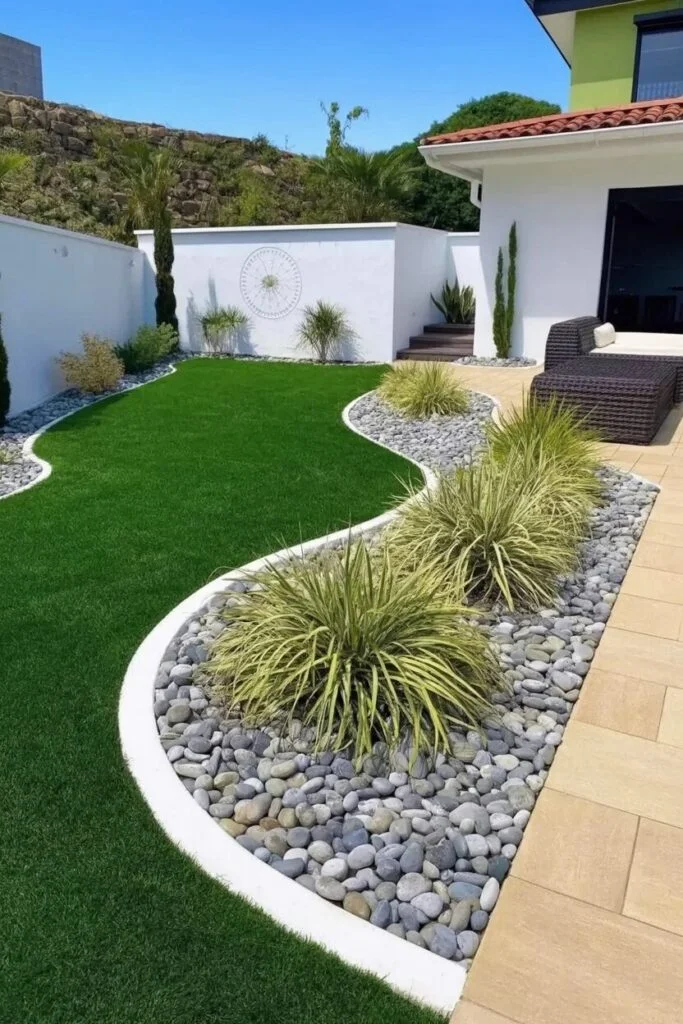The Insider Secrets for Lush Front Yards Without Grass
Tired of spending your precious weekends wrestling with a lawnmower? Yearning for a front yard that’s beautiful, low-maintenance, and a little more… you? You’ve come to the right place! We’ve spent countless hours exploring the most stunning front yards that prove you don’t need a single blade of grass to have an incredible landscape.
Grass-free landscaping isn’t just a rebellious act against the suburban norm; it’s a brilliant move for water conservation, less work, and more personality. We’ve compiled ten of our favorite ideas, breaking down the pro secrets behind each one so you can get the look you love. Get ready to turn your “yard work” into “yard fun”!
The Secret to Symmetrical Serenity
This garden just radiates calm, doesn’t it? It’s a perfect example of using formal balance to create a sophisticated, polished look. Notice how the manicured globe-shaped shrubs mirror each other, leading your eye down a clear line. It’s almost like a botanical runway!
From our experience, this landscaping tells everyone you’ve got your design principles down pat. We love the contrast of the dark mulch against the bright green of the plants. The secret is creating a clear sense of order, which makes the whole space feel incredibly neat and well-cared-for.
To recreate this, we recommend choosing low-maintenance plants like boxwoods. Use a tape measure for perfect spacing, and don’t be afraid to invest in a good pair of shears for pruning. Your neighbors will think you hired a pro, but it’s just you showing off your eye for balance.
Curves That Give Your Home a Hug
Forget straight lines; this landscape proves that soft, organic shapes can be the most inviting. The winding stone path isn’t just for walking; it’s an invitation to wander.
We’ve found that this style masterfully uses rhythm and flow to make the space feel natural and connected. The different colored stones add a playful touch, while the varied plant heights and textures keep the eye moving. By avoiding harsh angles, this design feels more relaxed and welcoming, almost like a warm embrace.
If you want to try this, use a garden hose to outline your path before laying down any pavers. And trust us: mix up the textures! The contrast between spiky and soft plants is what makes this look truly dynamic.
Mastering the Art of Rustic & Rocky
This design is a masterclass in using natural materials and embracing texture. The large, rugged boulders serve as a focal point and a visual anchor. The use of different-sized river stones creates a fascinating textural tapestry underfoot.
We’re big fans of the mix of drought-tolerant plants like agave and salvia, which not only look amazing but also make this yard super low-maintenance. This style leans into a sense of place and creates harmony by using elements that belong there naturally.
To pull this off, we highly recommend sourcing local rocks and stones—it’ll save money and give the landscape a genuine feel. When choosing plants, focus on those that thrive in your climate. This is an expert-level design for someone who wants to embrace the natural beauty of their surroundings.
READ MORE >> “9+ Home Greenhouse Ideas You Want to Recreate InstantlyI“
Stepping Your Way to a Grand Entrance
Talk about a wow factor! This front yard uses leading lines and scale to create a dramatic pathway. The large, round stepping stones surrounded by dark gravel create a clear, elegant path.
The verticality of the plants adds a sense of height and importance, making the entrance feel grand. We know from experience that a well-designed path dramatically increases curb appeal. This style perfectly balances simplicity and elegance, proving that you don’t need a lot of complexity to make a big impact.
Our tip for recreating this? Measure twice, lay once! For a professional look, choose uniform pavers with a clean cut. Also, select plants that echo the lines of your home—if your house is tall, use tall plants to complement it.
A Modern Take on Textural Wonderland
This one is for the plant lovers! This landscape design is all about embracing texture and variety to create a lush, modern look. Instead of manicured hedges, we see a beautiful, wild mix of textures—from the fine blades of grasses to the bold, sculptural leaves of agave.
The irregular stone pavers feel both modern and natural, creating a seamless connection to the garden. The use of mulch and various plant heights creates a rich, layered effect, making the space feel full and abundant without a single blade of grass.
As a rule of thumb, we advise building up from the ground. Start with a weed barrier and a thick layer of mulch before placing your plants. Don’t be afraid to mix different plant types with contrasting leaf shapes. The key is creating a textured tapestry that celebrates plant personalities.
Straight Lines and Structured Style
This is a lesson in repetition and clean lines. The linear design feels modern and incredibly tidy, proving that a grass-free yard can be just as structured as a traditional lawn. The parallel stepping stones, separated by different colored gravels and mulch, create a strong sense of order and rhythm.
The small, tidy plants are repeated at regular intervals, which helps to unify the entire space. We particularly appreciate how the dark edging defines the beds, giving the entire landscape a crisp, finished look. To recreate this, get out your measuring tape and keep your lines straight! This is all about precision.
Choose plants that are easy to keep uniform and low to the ground. This style is perfect if you love a minimalist aesthetic and want your front yard to feel calm and perfectly organized.
Cactus Gardens: The Ultimate Low-Water Oasis
If you live in a hot, dry climate, this might just be your new favorite front yard. This design is a masterclass in xeriscaping, a landscaping style focused on low-water plants. The striking forms and scale of the cacti and succulents are the true stars here.
Instead of a green lawn, you get a sculpture garden! The different plant shapes—from the towering saguaro to the round barrel cacti—create a dynamic, almost otherworldly landscape. We have to admit, this is a look for the bold, but it’s incredibly rewarding.
To pull this off, select plants that are native or well-suited to your climate. Remember that drainage is key, so use a mix of coarse sand and gravel. This isn’t just a garden; it’s an ode to durability and dramatic beauty.
READ MORE >> 9+ Ornamental Grass Ideas to Elevate Your Yard
Potted Plants: The Ultimate Commitment-Free Landscaping
This look is for all of us who appreciate great design but also enjoy the freedom to change our minds! This gorgeous collection of pots shows how you can use container gardening to create a stunning, grass-free landscape. We love this approach because it gives you total control over focal points and composition.
You can group pots by size, shape, or plant type to create visual interest. What makes this look so appealing is the mix of materials—from terracotta to textured concrete—which adds depth and a personal touch. To recreate this, we recommend starting with a variety of pots in different sizes and textures.
Play around with groupings, placing taller plants in the back and shorter ones in the front, to create a layered look. The best part? You can rearrange them on a whim. It’s perfect for the indecisive designer in all of us!
Curvy Paths and Colorful Mulch
This landscape is a celebration of color, texture, and rhythm. The winding path, bordered by a rustic stone edge, creates a natural, inviting flow that feels much more organic than a straight line. We’re particularly obsessed with the use of colorful, red mulch.
It instantly adds a pop of warmth and frames the different plant groupings beautifully. This design uses variety to its advantage, blending low-growing plants, spiky forms, and soft grasses to keep the eye entertained. To recreate this cheerful look, we suggest sketching out your path with a garden hose first to get the curve just right.
Be bold with your color choices! Don’t be afraid to experiment with different shades of gravel or mulch to create a unique backdrop for your plants. It’s a great way to show off your personality and make your home stand out.
Night Lights, Big Impact
Who says landscaping is only for daytime? This image is a fantastic example of using lighting design to transform your front yard into a magical space after sunset. The soft glow from the in-wall lights not only illuminates the path but also highlights the beautiful texture of the stone wall and the plants.
It’s about creating ambiance and safety at the same time. The gentle curve of the path and wall is a perfect example of a leading line that guides visitors to your door. We’ve seen this done in countless projects, and it never fails to impress. To get this look, consider hiring a professional for a safe, low-voltage lighting system.
For a simple DIY option, you can use solar-powered path lights. Focusing the light on key elements—like a unique plant or a section of the wall—adds a touch of high-end design without the high-end cost.
The Grass-Free Life: It’s More Than Just a Yard, It’s a Vibe!
And there you have it—ten beautiful, low-effort, and high-style ways to ditch the grass for good. From perfectly symmetrical designs to bold, colorful oases, we’ve covered a wide range of looks that are as unique as you are.
As landscape enthusiasts, we’ve seen firsthand how a little planning and a lot of personality can transform a tired lawn into a stunning outdoor extension of your home. You now have the principles and the tips you need to make it happen.
So, what are you waiting for? Pick your favorite style, roll up your sleeves, and start creating the grass-free front yard you’ve always dreamed of. Your weekends (and the planet!) will thank you for it.

